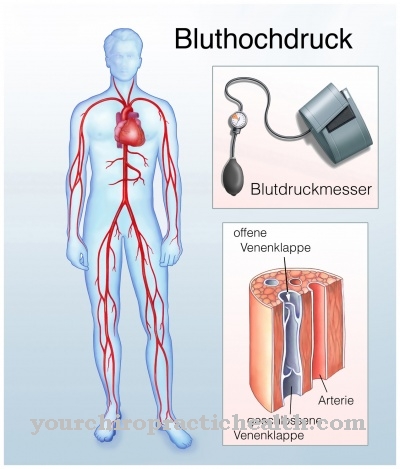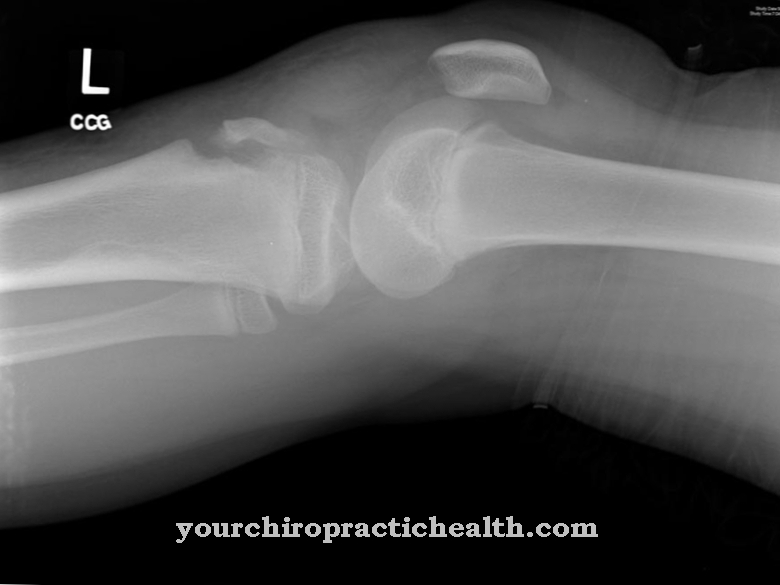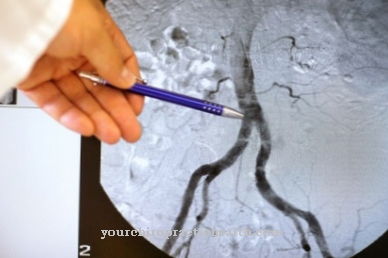In the Ichtyosis vulgaris it is a skin disorder that manifests itself in cornification disorders. Ichtyosis vulgaris is a hereditary disease that is associated with symptoms such as dry and flaky skin. Ichtyosis vulgaris is either an autosomal dominant or an x-linked recessive inheritance.
What is ichtyosis vulgaris?

© Alila Medical Media - stock.adobe.com
In principle, doctors differentiate between two forms of Ichtyosis vulgaris according to the respective inheritance pattern. The autosomal dominant expression is the form of ichtyosis vulgaris that occurs with the greatest frequency. The patients are affected by genetic mutations on gene location 1q21.
The corresponding gene area is responsible for coding the filaggrin protein, which plays an important role in the formation of structures in the skin. The x-linked recessive inherited form of ichtyosis vulgaris occurs somewhat less frequently. The Ichtyosis vulgaris is in the colloquial language as so-called Fish scale disease known.
The term refers to the typical appearance of the skin in the context of ichtyosis vulgaris. In Germany, it is estimated that over 100,000 people suffer from ichtyosis vulgaris. The disease manifests itself especially in the winter season due to the cold temperatures.
For many of those affected, ichthyosis vulgaris represents a considerable psychological distress, as the sufferers perceive the appearance of the skin as unaesthetic. Ichtyosis vulgaris is particularly evident in the area of the legs and arms and on the trunk of the body. The scaly structure of the skin surface intensifies, especially in winter.
In addition, ichtyosis vulgaris makes the skin very dry and prone to roughness and cracks. Around a quarter of those affected also suffer from neurodermatitis at the same time. In these people, ichtyosis vulgaris is usually associated with itching.
causes
Ichtyosis vulgaris occurs as a result of genetic mutations. While the autosomal dominant expression of ichtyosis vulgaris develops through gene mutations on the locus 1q21, the X-linked recessive inherited form results from mutations on the X chromosome and the gene location 22.32. This area is responsible for coding an enzyme called steroid sulfatase.
The defect leads to errors in the production of the enzyme, so that the skin's building processes are disrupted. Basically, this form of ichtyosis vulgaris manifests itself only in male patients. Because men only have a single X chromosome, while women have two and thus only act as genetic carriers of ichtyosis vulgaris without showing symptoms themselves.
Contact with water or moist air usually increases the symptoms of ichthyosis vulgaris. Skin irritants should also be avoided by those affected as they worsen the symptoms.
Symptoms, ailments & signs
The first manifestation of ichthyosis vulgaris usually takes place in patients as early as infancy. The symptoms of ichthyosis vulgaris increase continuously up to the pubertal growth phase, until finally stagnation and a subsequent regression set in. Ichtyosis vulgaris is characterized by very dry skin with a strongly pronounced line pattern of the individual skin cells.
The dryness of the skin results from a deficiency in the protein filaggrin. While the x-linked recessive variant of ichtyosis vulgaris usually only occurs in men, the autosomal dominant form appears equally in both male and female individuals. Under normal circumstances, the skin is permanently losing flakes.
In ichtyosis vulgaris, however, the scales are attached to the skin for a long time because the breakdown processes are impaired. Due to the reduced activity of the sebum glands, the skin appears matt and without shine. In principle, the severity of ichtyosis vulgaris varies greatly from case to case. Mild progressive forms sometimes go completely unnoticed. Ichtyosis vulgaris usually regresses gradually in adult patients.
Diagnosis & course of disease
The diagnosis of ichthyosis vulgaris is made by a dermatologist on the basis of typical signs and clinical examination methods.The anamnesis establishes the previous course of ichtyosis vulgaris and similar cases in the family. During the visual examination, the doctor registers the characteristic appearance of the skin with the characteristic scale pattern.
A molecular genetic examination of the patient is used to confirm the diagnosis of ichthyosis vulgaris. In this way, the doctor identifies the genetic defects on the corresponding genes, so that mix-ups with other skin diseases are almost impossible. Histological examinations of the skin areas affected by ichthyosis vulgaris additionally support the diagnosis.
When should you go to the doctor?
A visit to a doctor is advisable as soon as skin abnormalities or changes in the complexion appear. Since ichthyosis vulgaris is a congenital disorder, the peculiarities of the skin are often noticed immediately after the birth by the obstetrician or later by the pediatrician. In many cases, the parents do not have to take action themselves with this disease, as diagnosis can be made very early on. In the case of particularly dry skin and flaking of the skin layers, the observations should be discussed with a doctor. If the complexion shows a pattern of lines or a particular sheen, this can be an indication of a disorder.
A sighting of the skin and a blood test provide information about the presence of the hereditary disease. If the changes in the skin increase in size or intensity, a doctor should be consulted. If emotional problems set in due to the visual abnormalities, it is also advisable to consult a doctor. The visual flaw can cause emotional distress. A doctor should therefore be consulted in good time so that no mental illnesses develop. If the skin changes lead to pain, general malaise or restricted mobility, a doctor's visit is necessary. A doctor is required in the event of sensory disturbances, impaired sensitivity or numbness of the skin.
Doctors & therapists in your area
Treatment & Therapy
The causes of ichthyosis vulgaris cannot be treated, which is why the focus is on alleviating the symptoms. The patients usually receive special creams that grease the skin and support the peeling. For example, the supply of lactic acid, which supports the skin's natural protective acid mantle, plays an important role. UV therapies and salt baths also help if used regularly.
You can find your medication here
➔ Medicines against redness and eczemaOutlook & forecast
Ichthyosis vulgaris usually takes a protracted course. How severe the disease is depends on its form and when treatment is started. In severe cases, the sick child dies shortly after birth or in the first few weeks of life.
The symptoms usually develop within the first few months of life and significantly reduce the child's quality of life and well-being. Early therapy can reduce the symptoms and discomfort of the skin to such an extent that those affected can lead a relatively normal life. Nevertheless, the sick must always be treated with medication, which means a further burden.
A mildly pronounced ichthyosis vulgaris nevertheless promises a positive prognosis. Close medical treatment can reduce the suffering to such an extent that those affected can live a symptom-free life. The cause of the skin disease cannot be treated. Therefore, there is always the risk that a seemingly overcome ichthyosis vulgaris will recur.
The disease does not reduce life expectancy as long as the child survives the first few weeks of life without permanent damage. However, as a result of the external changes, inferiority complexes and other mental complaints can develop.
prevention
A causal prevention of ichthyosis vulgaris is not possible. Patients avoid frequent skin contact with water and skin-irritating substances. These measures are particularly important when choosing a career and help avoid unnecessary aggravation of the symptoms of ichthyosis vulgaris. Regular medical checks and individually tailored treatment of ichthyosis vulgaris usually show good results.
Aftercare
In most cases, those affected with ichthyosis vulgaris do not have any special follow-up measures available. This disease must be diagnosed by a doctor very early in order to prevent further worsening of the symptoms. As a rule, it cannot heal on its own, so that those affected are definitely dependent on a visit to a doctor.
With ichtyosis vulgaris, intensive care of the skin is advisable. The skin should be treated with various creams and ointments as often as possible to alleviate the symptoms. A high standard of hygiene must also be observed so that the symptoms can be properly alleviated. Some people are dependent on various medications due to ichthyosis vulgaris.
It is always important to ensure that the dosage is correct and that it is taken regularly. If anything is unclear or if you have any questions, a doctor should be consulted first. Furthermore, with Ichtyosis vulgaris, the support and help from your own family or friends is very important, as this can also prevent psychological upsets or depression.
You can do that yourself
Ichthyosis vulgaris must be clarified and treated by a doctor. In addition to drug therapy, the person affected can take some measures to alleviate the symptoms and prevent the skin disease from progressing further.
The most important measure is the daily care of the skin. If the disease occurs, the skin must be bathed twice a day, carefully rubbed off and treated with a suitable care product. For example, urea-containing creams, but also natural creams made from lemon balm or chamomile are suitable. As long as the skin is not inflamed, preparations with vitamin A acid can also be used. Arsenicum album, Rhus toxicodendron and other homeopathic remedies support the treatment of ichthyosis vulgaris. The family doctor responsible must always decide which means can be used.
Regular check-ups are mandatory for ichthyosis vulgaris. In addition to local therapy, psychological treatment is usually also useful. In conversation with a therapist, the person concerned learns to accept the skin changes and to overcome their social fears. Visiting a self-help group supports psychological support and gives the person affected the opportunity to exchange ideas with other ichthyosis patients.

.jpg)






















.jpg)



